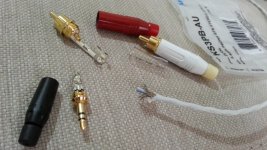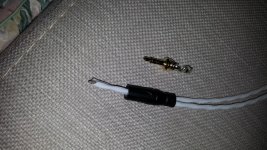Hello.As i see there are different ways of making a RCA cable.I have many Teflon Cables and i want to build a 3.5mm to RCA cable for using with my ipad air(i already have a 3meters of Monster cable and i want to build a better sounding one) I am not sure how to build a good one with these parts.Could anyone help?
Attachments
Should i connect shield wires to both white cable ends or only connect to 3.5mm side?Some people say connect to both end and someone tell to only one side?
And second question.Should i twist 2 cables too or leave them alone?
And second question.Should i twist 2 cables too or leave them alone?
Attachments
Last edited:
It looks like your cable is 2core+shield.
Use the 2cores to carry the signal (Signal Flow and Signal Return)
Use the shield to attenuate interference.
The shield must be connected to the source chassis.
But I suspect your source does not have a chassis, so next best is to connect the Shield to the Signal Return at the Source end.
Where you have a chassis connected shield and high interference especially at VHF, then you should also connect the shield to chassis at the receive end.
Sometimes this receive end connection to Chassis can be via a very low inductance capacitor.
Do NOT use the shield in parallel to the Signal Return !!!!!!!!!!!!!!
Teflon is reputed to be bad for "triboelectric" effect.
https://en.wikipedia.org/wiki/Triboelectric_effect
I suggest you do not use this for a flexible interconnect.
Use it for fixed wiring where it is well supported to prevent flexure due to vibrations.
Otherwise throw it in the bin.
Use the 2cores to carry the signal (Signal Flow and Signal Return)
Use the shield to attenuate interference.
The shield must be connected to the source chassis.
But I suspect your source does not have a chassis, so next best is to connect the Shield to the Signal Return at the Source end.
Where you have a chassis connected shield and high interference especially at VHF, then you should also connect the shield to chassis at the receive end.
Sometimes this receive end connection to Chassis can be via a very low inductance capacitor.
Do NOT use the shield in parallel to the Signal Return !!!!!!!!!!!!!!
Teflon is reputed to be bad for "triboelectric" effect.
https://en.wikipedia.org/wiki/Triboelectric_effect
I suggest you do not use this for a flexible interconnect.
Use it for fixed wiring where it is well supported to prevent flexure due to vibrations.
Otherwise throw it in the bin.
Last edited:
Ok i see.I want to give it a try.So i am connecting everything to 3.5mm plug and leave shield not connected to rca?rgrds
I would use co-ax for the job. A shield connected at one end is not a shield.... Its a piece of wire connected at one end, only audio seems to go for the one end connection of shields. At least use a cap at one end to give some RF shielding....
Also look at what these guys say...
http://www.hottconsultants.com/pdf_files/aes-2007.pdf
http://www.hottconsultants.com/pdf_files/Audio Interconnections.pdf
https://centralindianaaes.files.wordpress.com/2012/09/indy-aes-2012-seminar-w-notes-v1-0.pdf
Also look at what these guys say...
http://www.hottconsultants.com/pdf_files/aes-2007.pdf
http://www.hottconsultants.com/pdf_files/Audio Interconnections.pdf
https://centralindianaaes.files.wordpress.com/2012/09/indy-aes-2012-seminar-w-notes-v1-0.pdf
Cable isn't supposed to "sound" - if it does then something is wrong. For the closest approach to the original sound use a high quality source and a cheap PVC-insulated copper cable.
From here which cable is best for my application?
Audio-Video Cables - 2MKABLO
My friend already gave me a sample of 5 feet of this ,he says that they are building many systems with this
http://en.2mkablo.com/audio-video-cables/unbalanced-and-balanced-installation-cables/hfia22-angel
but i think this may be better
http://en.2mkablo.com/audio-video-c...balanced-installation-cables/hfia20-pr0-angel
Audio-Video Cables - 2MKABLO
My friend already gave me a sample of 5 feet of this ,he says that they are building many systems with this
http://en.2mkablo.com/audio-video-cables/unbalanced-and-balanced-installation-cables/hfia22-angel
but i think this may be better
http://en.2mkablo.com/audio-video-c...balanced-installation-cables/hfia20-pr0-angel
Last edited:
There are many copper cored twisted pairs and copper cored screened twisted pairs to choose from.
I would use cable with a outer jacket diameter that suits your nice plugs, then you get good physical cable termination.
Join the jack cable and RCA cables outside the jack plug for the same reason.
Termitate shield on jack only to avoid ground loops.
Radical suggestion : Terminate signal ground only on one RCA plug to avoid ground loop via right and left channel. Both channels has to be connected for cable to function.
Summed up: Avoid ground loops. Solid mechanical terminations.
Regards Torgeir
Join the jack cable and RCA cables outside the jack plug for the same reason.
Termitate shield on jack only to avoid ground loops.
Radical suggestion : Terminate signal ground only on one RCA plug to avoid ground loop via right and left channel. Both channels has to be connected for cable to function.
Summed up: Avoid ground loops. Solid mechanical terminations.
Regards Torgeir
So it is quick and easy to make an inappropriate cable.AndrewT said:Twisted pair solder just fine into RCA/Phono plugs and onto the back of RCA/Phono sockets.
There is no easy answer to the 'correct' way to wire a shielded twisted-pair cable for an unbalanced connection. Perhaps the best option (apart from the true correct way - use coax) is to use one wire as signal return, ground the shield at one end, and RF ground the shield via a small capacitor at the other end too.
As I said in another thread, twisted-pair is not 'better' than coax. It is the correct wire to use for a balanced connection, just as coax is the correct wire to use for an unbalanced connection.
I remember your comments.
But I still have some doubts as a result of one reading of H.Ott.
If I understood him correctly he seemed (to me) to be showing data that made shielded twisted pair at least as good as coax for connections.
Maybe it's time I went back with your comments in mind and re-read Ott
But I still have some doubts as a result of one reading of H.Ott.
If I understood him correctly he seemed (to me) to be showing data that made shielded twisted pair at least as good as coax for connections.
Maybe it's time I went back with your comments in mind and re-read Ott
audio-video-cables,unbalanced-and-balanced-installation-cables,IA20 PR0-ANGEL - 2mkablo.com
Monster uses this kind of cable in their rca cables.
Monster uses this kind of cable in their rca cables.
Last edited:
Radical suggestion : Terminate signal ground only on one RCA plug to avoid ground loop via right and left channel.
This is beacause conductors have slightly different impedance or different impedance of the soldering so noise can be induced in the loop. This is the same argument that is used by stargrounding. So it is not the different potential in the two boxes that is primarely addressed.
Normally different potential will generate orders in magnitude more noise than violating stargrounding, so normally it is a small factor in low current systems or systems with low amplification. For unbalanced stereo mics or MC pickup cables, it can matter.
The IA20 looks good with specified parameters so I would not be afraid to use that cable if the diameter fits your connectors.
This is beacause conductors have slightly different impedance or different impedance of the soldering so noise can be induced in the loop. This is the same argument that is used by stargrounding. So it is not the different potential in the two boxes that is primarely addressed.
Normally different potential will generate orders in magnitude more noise than violating stargrounding, so normally it is a small factor in low current systems or systems with low amplification. For unbalanced stereo mics or MC pickup cables, it can matter.
The IA20 looks good with specified parameters so I would not be afraid to use that cable if the diameter fits your connectors.
the two interconnects external to the amp chassis are probably sharing a common signal ground at the Source end.
This creates a ground loop that can impose interference voltages on the two signal grounds and this interference is still read by the amplifier as a signal voltage.
Look at Leach's alternative RCA/Phono grounding in his Low Tim paper.
He uses TWO wires to connect signal to amplifier and that necessitates 4 wires from input to stereo amplifiers and a further low impedance resistor connection inside BOTH amplifiers to their respective Power Grounds.
This creates a ground loop that can impose interference voltages on the two signal grounds and this interference is still read by the amplifier as a signal voltage.
Look at Leach's alternative RCA/Phono grounding in his Low Tim paper.
He uses TWO wires to connect signal to amplifier and that necessitates 4 wires from input to stereo amplifiers and a further low impedance resistor connection inside BOTH amplifiers to their respective Power Grounds.
So it is quick and easy to make an inappropriate cable.
There is no easy answer to the 'correct' way to wire a shielded twisted-pair cable for an unbalanced connection. Perhaps the best option (apart from the true correct way - use coax) is to use one wire as signal return, ground the shield at one end, and RF ground the shield via a small capacitor at the other end too.
As I said in another thread, twisted-pair is not 'better' than coax. It is the correct wire to use for a balanced connection, just as coax is the correct wire to use for an unbalanced connection.
Coax cables do not have OFC copper.The others in the list have.
As it is a stereo phone plug at the source/ipad side there is common ground there. So my radical suggestion is to mimic a cheap cable with left and right channel inside the ground shield, which is also the return signal / signal ground. It is that electrical connection without the signal bleed between the channels and signal ground through the shield.
I am not a big fan of coax myself at low frequency because of the unflexible cables and high risk of breaking the solid senter connector when bending the cable.
I guess the Ipad does not have much internal OFC?
Regards Torgeir
I am not a big fan of coax myself at low frequency because of the unflexible cables and high risk of breaking the solid senter connector when bending the cable.
I guess the Ipad does not have much internal OFC?
Regards Torgeir
Coax cables do not have OFC copper.The others in the list have.
What a silly reply, look around at all the available co-ax's for audio... what is required is a co-ax with a good screen, that means low resistance and 100% coverage... the low resistance for the screen is a very important factor.
To use twisted pair you would have to have proper balanced routing from source to destination and to have a chassis grounding scheme for the cable screen, a mix and match approach with balanced and single ended signal routing will not work.
- Status
- Not open for further replies.
- Home
- Design & Build
- Construction Tips
- 3.5mm to rca PTFE cable build

